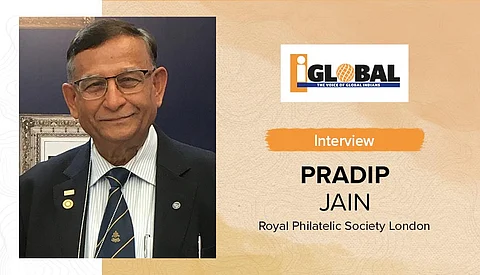

Pradip Jain is a member of the prestigious Royal Philatelic Society London, one of the oldest and most significant philatelic organisations in the world established under the patronage of King George V. Jain holds the honour of being the third Indian signatory to this illustrious society in over a century, a recognition that reflects his immense contributions in the field of stamp collection.
Philately, the art and science of stamp collecting, serves as a window into history, culture, and progress. In Jain’s own words, each postage stamp has a story to tell. From tracing pivotal historical events to celebrating our flora and fauna, stamps are a powerful medium of cultural preservation and communication.
In this interview, Pradip Jain shares many a fascinating stories from his stamp collection experiences, showcasing the history of Diwali through philately and the global appeal of stamps.
Tell us more about philately and the Royal Philatelic Society London.
Philately is the advanced form of stamp collecting. Stamp collecting is a very common hobby shared by many but those who make advancement in the field are called philatelists. It is a very big community around the world. I started off as a stamp collector, and now over the years, I'm a philatelist.
The Royal Philatelic Society, which I joined in 2010, is one of the oldest societies with over 2,800 members around the world, with headquarters in London. King George V was a very well-known collector of stamps. He was the first founder, President and patron of the Royal Philanthropic Society. To this day, Buckingham Palace houses a huge Royal Collection of stamps which I had the privilege to visit when I was doing research on the 1948 Mahatma Gandhi stamp issued in India for my book.
All the leading stamp collectors in the world are members of the Royal Philatelic Society. The RPC host several lectures, seminars and exhibitions there throughout the year. Both the RPC and the Royal Collection have vast collections on Indian stamps since it was under the British Empire.
How did the Diwali stamps come about?
Like Christmas, the festival of Diwali is also now getting very popular around the world and is celebrated everywhere, especially places which have a lot of Indian diaspora. India has come out with Diwali stamps but Guyana is the first country to come out with a Diwali stamp.
Stamps are like an ambassador to the world and they are a powerful way to communicate to the people at large. Many Indians living abroad are stamp collectors and are involved in the field.
What drew you towards philately?
Every hobby has a beginning somewhere. For me, when I was very young, I visited a stamp exhibition in my town in the year 1969. Since it was Mahatma Gandhi's centenary, there were a lot of Gandhi centenary stamps on display. This was my first introduction to stamp collection.
Later, I visited the philatelic campus in the Patna General Post Office where they had a small stamp exhibition, which fascinated me so much that I bought a few stamps from the dealer there. So I bought some stamps from the dealer over there. And that’s how my interest started growing. Initially, I was just collecting but I soon realised it was not possible to buy all the stamps with my limited pocket money. That is when I started buying them from other places like Kolkata and when they arrived in my village in Patna, I would sell them.
Through a pen friend club, I began collecting stamps from around the world. I eventually had stamps from over 30 countries through this and I would send them back the Indian stamps. I thought this was a very good way of living; doing business and sustaining my hobby too. This is how my hobby of stamp collecting became a professional journey into the philatelic world.
*Info: Phila Art